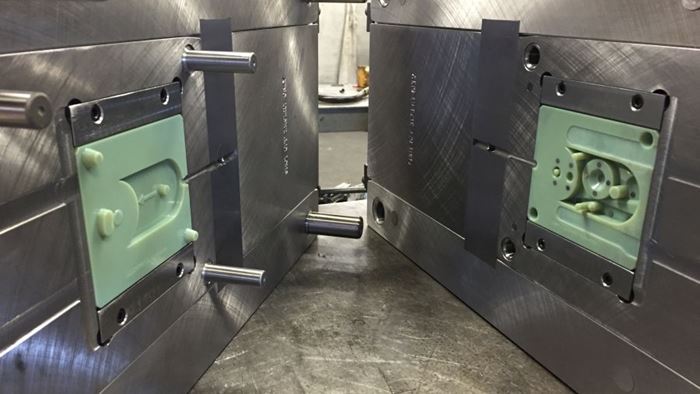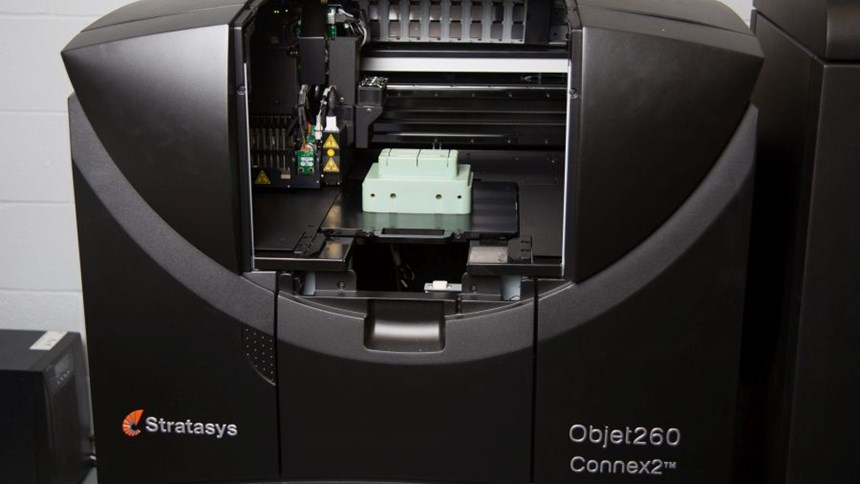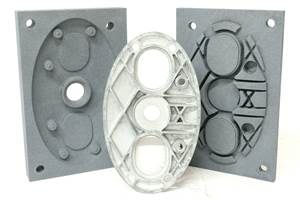Expanding Horizons with Rapid Tooling
Investing in 3D printing for rapid tooling brought product development time from months down to weeks for this moldmaker.
Providing customers with the ability to produce a production-intent component in the production-specified engineered resin in days rather than weeks is the goal of many mold manufacturers and molders. But today, Accu-Mold LLC, a certified minority business enterprise based in Portage, Michigan, can say they reached that goal. The company recently invested in rapid tooling capabilities using 3D printing.
After years of outsourcing 3D printing, Accu-Mold decided to install a Stratasys Objet260 Connex2 and Objet30 Pro mid-2015 to print sample parts and molds to speed product development time for its customers.
Accu-Mold specializes in metal to plastic conversion, but didn’t just want to deliver 3D-printed components. They wanted to leverage additive manufacturing (AM) for rapid tooling development, according to Accu-Mold President Dave Felicijan.
The addition of AM for rapid tooling affords their customers a much shorter lead time over multiple standard aluminum prototype molds and trials. 3D-printed rapid tools can be turned around within three to six business days while maintaining the integrity of the production-intent material for both design and product validation.
And with the analytical design tools at their disposal, such as MoldFlow, FEA and cooling analysis, and the ability to prototype quickly, Accu-Mold can ensure an efficient manufacturing process within weeks as opposed to months. This means their customers get their products to market much sooner.
To date, Accu-Mold has produced a number of printed tools and each one presents its own set of challenges. For example, getting cooling into the mold or using some type of system to quickly cool the part before ejection. “To date, we have printed three tools and their respective molded parts. We also have two more in design. The first three were single-cavity prototype tools and the other two in design are single-cavity production pull ahead tools,” says Felicijan.
The first rapid tooling project was for the welding aftermarket component industry. The part is used for wire welding and is assembled in a “chain” to straighten the wire as it is pulled from a distance. The geometry of the part proved to be challenging due to thin walls and deep draw. However, Accu-Mold used recommended guidelines for the ratio of wall thickness, maximum material load, etc. from the printer manufacturer, as well as experience with standard tooling prototypes and scientific molding, to design and build the rapid tool.
Stratasys’ digital ABS material was used along with proprietary cooling, and runner and gate sizing calculations based on product size, material and wall thickness. The tool was built in four business days with molded production-intent components on the fifth business day. This project saved thousands of dollars in labor and material compared to a standard aluminum prototype tool.
Felicijan notes that Accu-Mold’s customers have been eager to use the rapid tooling capability for components that would normally take 12 to 14 weeks for prototyping and design validation testing. “When the process is presented to the customer, they want to use it right away. However, it doesn’t meet the needs of all applications. It’s important to act quickly yet realistically based on the variables presented. For example, we have development underway for higher temperature materials,” says Felicijan.
Currently, about 60 percent of Accu-Mold’s business is mold building and 40 percent is automotive and commercial molding. The company is looking to use its new AM capabilities to diversify into medical and defense products because of their reduced product life cycles and legacy component and assemblies, respectively. Additionally, Accu-Mold hopes to achieve a higher concentration of contract manufacturing by expanding into advanced AM, including metal 3D printing.
Related Content
3D Printing Enables Mold Shop to Rapidly Prototype Medical Parts (Video)
A case study involving Mantle’s 3D printing technology allowed moldmaker Westminster Tool to go from design to injection molded prototype medical parts in three weeks.
Read MoreFoundry Lab: How Casting in a Day Will Improve the Design of Metal Parts (Includes Video)
The company’s digital casting process uses 3D printing, but the result is a cast part. By providing a casting faster than a foundry, the company says effective prototyping is now possible for cast parts, as well as bridge production.
Read MoreHow to Build 10,000+ Shot Molds in Hours
Rapid tooling isn’t so rapid when it takes days to 3D print a metal mold, and then you still must machine it to reach the necessary tolerances. With Nexa3D’s polymer process you can print a mold in hours that is prototype or production ready and can last for more than 10,000 shots.
Read MoreFaster Iteration, Flexible Production: How This Inflation System OEM Wins With 3D Printing
Haltec Corp., a manufacturer of tire valves and inflation systems, finds utility in 3D printing for rapid prototyping and production of components for its modular and customizable products.
Read MoreRead Next
To Improve Performance of Compression Molded Composites, Add 3D Printed Preforms
9T Labs' Additive Fusion Technology enables the manufacture of composite structures with as much or as little reinforcement as is necessary, using 3D printed continuous fiber preforms to add strength just where needed.
Read MoreLooking to Secure the Supply Chain for Castings? Don't Overlook 3D Printed Sand Cores and Molds
Concerns about casting lead times and costs have many OEMs looking to 3D print parts directly in metal. But don’t overlook the advantages of 3D printed sand cores and molds applied for conventional metal casting, says Humtown leader.
Read MoreGE Additive Rebrands as Colibrium Additive
As part of the brand name transition, both the Concept Laser and Arcam EBM legacy brands will be retired.
Read More













.png;maxWidth=300;quality=90)











